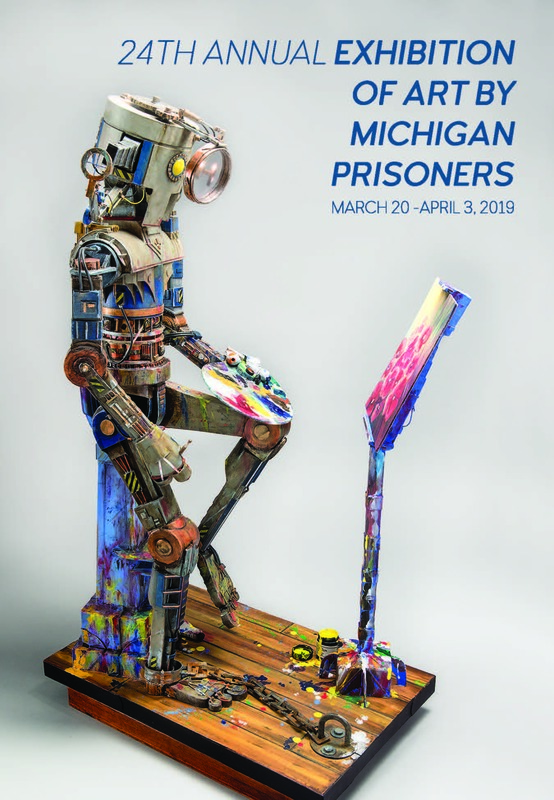History of the Annual Exhibition
The Annual Exhibitions of Art by Michigan Prisoners is a project of the Prison Creative Arts Project (PCAP) at the University of Michigan. PCAP was founded in 1990 by Buzz Alexander, professor of English at the University, when he began a theatre workshop at a women’s prison and soon began teaching classes in which his students facilitated theatre and writing workshops in prisons and juvenile facilities. In 1995, Janie Paul, a visual artist and professor at the University of Michigan School of Art & Design, joined Buzz in this project, facilitating visual art workshops herself and with her students. Over the following decades, PCAP grew into a robust University program that brings those impacted by the justice system and the University of Michigan community into artistic collaboration for mutual learning and growth.
Soon after founding PCAP, Buzz and Janie decided to organize an exhibition of art by incarcerated people. In 1996, they received permission from the Michigan Department of Corrections to visit prisons in the lower peninsula of Michigan and select artwork for a show. They were moved and impressed by the work they saw and the stories they heard from the artists. A rich new world was opened up to them. They saw that people in prison were developing artistic practices based on a need for expression and a way to assert their identity.
Seeing the profound effect that the exhibition had on the artists and the viewing public, Buzz and Janie decided to make the exhibition an annual event. By mounting the exhibition every year, PCAP provides a sustained support system for the artists inside – something they can count on going forward into the future with them. The goals of the exhibitions are to provide validation and support for the growth of each artist and to provide a way for the public to witness the humanity of incarcerated people through their art.
From the beginning, Buzz and Janie conceived of the exhibitions as pedagogical as well as curatorial projects. During each selection visit they engaged in discussion with the artists and gave feedback on their work. Returning to the prisons year after year, they engaged in dialogue with the artists as their work developed. Very quickly, word spread throughout the state prison system and more and more artists began to participate. After a few years, the project expanded to include artists at every state prison in both peninsulas of Michigan. PCAP students and community volunteers joined the project, attending art selection trips and helping to organize, photograph, and exhibit the work in Ann Arbor. The opening reception of the exhibition became a highly anticipated celebration that lifted up recently returned artists. Though the incarcerated artists could not attend the show, their families and other loved ones were invited. Artists were also included through communications throughout the year that brought them validation and connection.
Visitors flocked to the exhibition to see the work and learn about the community of incarcerated artists in Michigan. The artwork was sold at affordable prices, with the net proceeds of the sales going to the artists themselves. Visitors were delighted to support the artists and to be able to have original art that they could afford. A loyal group of patrons formed; they have continued to be a backbone of support for the exhibitions. Funding to support the exhibition also came from the Washtenaw Council for the Arts, the Michigan Council for Arts and Cultural Affairs, the Kellogg Foundation, and a Rockefeller Pact grant. In 2003, a National Endowment of the Arts Access Grant funded the first full-time administrator for PCAP. In 2009, the University of Michigan provided funds for more part-time staff and in 2013, the University funded three full-time positions for PCAP staff including a full-time Arts Programming Coordinator for the Annual Exhibitions. The curator group has also grown over the years and includes formerly incarcerated artists.
The exhibition has also served as a gathering space for prison activists and artists. As the most prominent public-facing project of PCAP, it afforded a way to connect with and highlight the work of activists and artists around the country. Each year, during the two weeks of the exhibition, curators and students organized panels and keynote talks that were held on campus or in the gallery. Participants in these events have included Sister Helen Prejean, anti-death penalty advocate and author of Dead Man Walking; formerly incarcerated poet and writer, Jimmy Santiago Baca, author of many books including A Place to Stand; formerly incarcerated political prisoners Susan Rosenberg and Kathy Boudin; Terry Kupers, a psychiatrist who testifies against solitary confinement; Elizabeth Fink, who fought for the inmates of the Attica rebellion; Phyllis Kornfeld, art educator in prisons and author of Cellblock Visions; Judith Tannenbaum, poet, teacher in San Quentin prison, and author of Disguised as a Poem; and Richard Kamler, visual artist who highlighted thorny issues of crime and captivity in his work. The connections formed by these events tied PCAP to the growing network of educators, activists and artists around the country.
PCAP has enjoyed a collaborative relationship with the Michigan Department of Corrections since its founding decades ago. Over the twenty-six years of the Annual Exhibition, MDOC administrators, wardens, and staff have continued to support the project. The culture of art in Michigan prisons has grown enormously, impacting thousands of people. The Annual Exhibition is now the largest curated exhibition of art by incarcerated people in the world. The first exhibition included seventy works by fifty artists from sixteen prisons. This year there are 828 works by 663 artists from all 28 state prisons.




